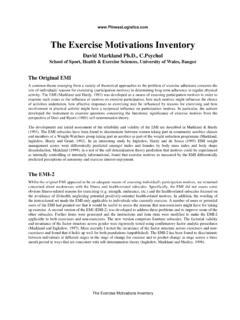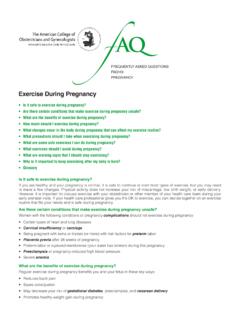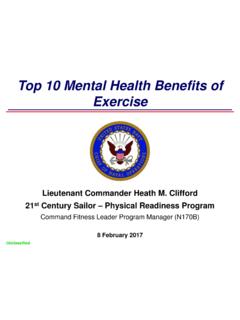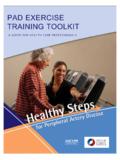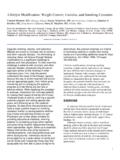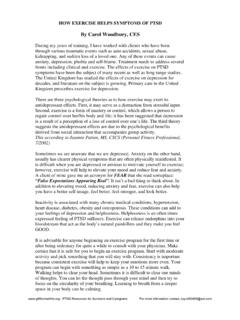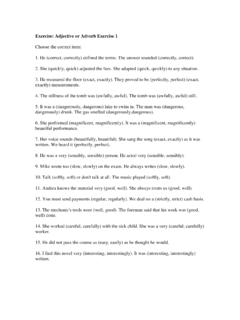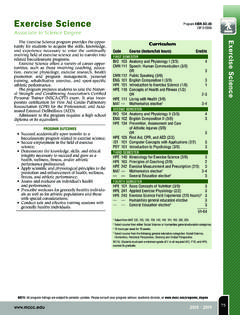Transcription of Considerations before starting an exercise program ...
1 The power of for the prevention and treatment of diabetesRegular physical activity can: Improve fitness Increase vigour Improve blood glucose control Decrease insulin resistance Improve lipid profile and blood pressure Help maintain weight loss Reduce morbidity and mortalityThe Canadian Diabetes Association CPGs recommend 150 minutes of aerobic exercise and 3 sessions of resistance exercise per week. Most people living with diabetes currently do not meet these a diabetes healthcare professional, you can substantially improve the adoption of regular physical activity (PA): Ask about PA at every diabetes-focused visit Use the new Canadian Diabetes Association Physical Activity and exercise tools here Advise inactive patients to get started Encourage and guide those who are active to maintain or progress further with their PAThe Canadian Diabetes Association 2008 Clinical Practice Guidelines for the Prevention and Management of Diabetes in Canada can be found at activity and exercise Key elements from the Canadian Diabetes Association 2008 Clinical Practice Guidelines for the Prevention and Management of Diabetes in | 1-800-BANTING (226-8464)Across the country, the Canadian Diabetes Association is leading the fight against diabetes by helping people with diabetes live healthy lives while we work to find a cure.
2 We are supported in our efforts by a community-based network of volunteers, members, employees, healthcare professionals, researchers and partners. By providing education and services, advocating on behalf of people with diabetes, supporting research and translating research into practical applications we are delivering on our Practice GuidelinesClinical Practice GuidelinesLow physical fitness is as strong a risk factor for mortality as power to improve your patients blood glucose control is in their feet!Physical activity can be as powerful as glucose-lowering fewer side : Paul Oh, MD MSc FRCPC416573 07/11 Considerations before starting an exercise programA physical activity program is generally safe and reduces health problems in persons with diabetes. Being inactive carries much more risk than being establishing an exercise prescription for choice and intensity of exercises, pay attention to and talk to your patients about:PResence of diABetes comPLicAtions Severe autonomic neuropathy Watch for dizziness or other evidence suggesting possible hypotension during or after exercise .
3 Severe peripheral neuropathy Be careful with prolonged weight-bearing exercise . Check your patient s feet and review the importance of proper footware. Proliferative retinopathy Should be treated prior to starting resistance conceRnsConsider an exercise stress test for those: With symptoms suggestive of heart disease, such as dyspnea or chest discomfort. Previously sedentary individuals, at high risk for cardiovascular disease, who wish to undertake a vigorous exercise program . muscuLoskeLetAL issues Back, hip and knee problems are common in people with diabetes. Consulting with a musculoskeletal professional ( , physiotherapist, kinesiologist) may be helpful prior to starting an exercise Discuss potential for hypoglycemia for patients taking insulin or oral medications (such as sulfonylureas) that may cause this.
4 Have patients self-monitor blood glucose before and after exercise for the first few sessions to look for hypoglycemia and to demonstrate effects of exercise on blood glucose levels. Have your patient be prepared to treat hypoglycemia during you to those who helped with content: Marni Armstrong, Ian Blumer, Normand Boul , Jonathon Fowles, Tessa Laubscher, Ruth Lowndes, Tino Montopoli, Jonathan McGavock, Jeff Packer, Nel Peach, Mike Riddell, Mike Sarin, Brian Seeley, Chris Shields, Ron Sigal, Ernst Snyman, Guy Tremblay, Pearl Yang, Catherine Yu. CDA: Hayat Ali, Tracy Barnes, Carolyn Gall :1. Church TS, Cheng YJ, et al. exercise capacity and body composition as predictors of mortality among men with diabetes. Diabetes Care. 2004; 27(1): Knowler WC, Barrett-Connor E, et al. Reduction in the incidence of type 2 diabetes with lifestyle intervention or metformin.
5 N Engl J Med. 2002; 346(6): Sigal RJ, Kenny GP, et al. Effects of aerobic training, resistance training, or both on glycemc control in type 2 diabetes: A randomized trial. Ann Intern Med. 2007; 147(6): The 5 A s adapted from: Estabrooks PA, Glasgow RE, Dzewaltowski DA. Physical activity promotion through primary care. JAMA. 289(22): Kirk A, Mutrie N, et al. Effects of a 12-month physical activity counselling intervention on glycaemic control and on the status of cardiovascular risk factors in people with type 2 diabetes. Diabetologia. 2004; 47(5): American College of Sports Medicine; American Heart Association. exercise and acute cardiovascular events: Placing the risks into perspective. Med Sci Sports Exerc. 2007; 39(5): Canadian Diabetes Association Clinical Practice Guidelines Expert Committee. Canadian Diabetes Association 2008 clinical practice guidelines for the prevention and management of diabetes in Canada.
6 Can J Diabetes. 2008; 32(suppl 1) modification can reduce the risk of developing type 2 diabetes by up to 60%. Incidenceof Diabetes (%) Engl J Med2 Getting going the 5 A s of PA promotion4 Assess: establish current PA level and readinessDetermine frequency, intensity, time and type of PA. Not active, not thinking about PA Not active, ready for PA Active and ready to maintain or progressAdvise: strongly encourage all patients to get more activeReview health risks, benefits of PA, appropriate amount and type of : collaboratively develop goals and a personalized action planProvide individually relevant exercise prescriptions, time frames and monitoring strategies to meet the : identify personal barriers and strategies to overcome barriers Identify connections and resources for exercise and PA in the community. Regional Canadian Diabetes Association offices Canadian Society for exercise Physiology (CSEP) Find an exercise professional ( ) Canadian Physical Activity Guidelines Canadian Association of Cardiac Rehab Find a local program ( ) Canadian Centre for Activity and Aging ( ) YMCAs and local fitness facilities Municipal / Community programs Canadian Kinesiology Alliance ( )Arrange: specify plan for follow-up at diabetes focused visits with telephone calls or email reminders Review PA level at subsequent visits and provide advice to achieve the next level of PA counselling includes: Discussion of decisional balance (pros and cons), barriers, opportunities and supports Development of specific action plans and goalsReady for PA?
7 Current ActivityAction Plan examples NONone Discuss benefits of PA Reduce sedentary timeYESO ccasionally physically active Plan for regular PA Add introductory resistance exercise YESR egularly active Progress aerobic exercise Add advanced resistance exercise table 1. Aerobic exercisedefinition and recommended frequencyintensityexamplesRhythmic, repeated and continuous movements of the same large muscle groups for at least 10 minutes at a timemoderate:50 70% of person s maximum heart rate Biking Brisk walking Continuous swimming Dancing Raking leaves Water aerobicsRecommended for a minimum of 150 minutes per week (moderate intensity)vigorous:> 70% of person s maximum heart rate Brisk walking up an incline Jogging Aerobics Hockey Basketball Fast swimming Fast dancingtable 2. Resistance exercisedefinition and recommended frequencyintensityexamplesActivities that use muscular strength to move a weight or work against a resistant load*3 times per week Start with 1 set of 10 15 repetitions at moderate weight Progress to 2 sets of 10 1 5 repetitions Progress to 3 sets of 8 repetitions at heavier weight exercise with weight machines Weight lifting*Initial instruction and periodic supervision are recommendedCPG chapters of interest Physical Activity and Diabetes Nutrition Therapy Management of Obesity in Diabetes Hypoglycemia Identification of Individuals at High Risk of Coronary EventsAerobic and resistance exercise significantly improves glycemic control (A1C)
8 Over 6 = Aerobic Training Rt = Resistance +RtA1cStructured counselling by healthcare professionals effectively increases PA Physical activity and exercise is safe cardiovascular complications occur in about 1/100,000 hours of in exercise time per weekno counsellingcounselling-14 mins+55 mins 1. Increase physical activity in your day and reduce sedentary time. Limit sedentary recreational time to no more than 2 hours per day. 2. Begin regular aerobic exercise * 4 days per week for 10 minutes per session. 3. Begin resistance exercise ** 2 days per week. 4. Continue to do regular aerobic exercise * 5 days per week for a minimum of 30 minutes per session. 5. Continue to do regular resistance exercise ** 3 or more days per activity and building strength in your major muscle groups can provide you with these benefi ts:Immediately Lower your blood glucose within 1 hour Improve your mood, sleep patterns and energy level Increase the effectiveness of the insulin your body makes or the insulin your doctor prescribes for youLong-term Improve your blood glucose control Reduce your body fat Help keep your pancreas, kidneys, eyes and nerves healthy Reduce the risk of heart attack, stroke and deathAs your healthcare provider, I recommend that you follow the physical activity prescription ticked below (choose all that apply): * Aerobic exercise is continuous, whole body exercise that elevates breathing and heart rate.
9 ** Resistance exercise involves doing various body movements with strong contractions to build muscle strength. Regular physical activity is one of the most important things you can do to manage and live well with your diabetes. Many people, however, need help starting an exercise routine and achieving these goals. The benefi ts of physical activity increase the more you do, from whatever your starting point. Refer to the information on the back of this form to help you get started with your physical activity prescription. If you need help, you can ask me or another member of your diabetes healthcare team for support that is right for you. The Canadian Diabetes Association 2008 Clinical Practice Guidelines for the Prevention and Management of Diabetes in Canada recommends that all people with diabetes:Get a minimum of 150 minutes of moderate-to-vigorous intensity aerobic exercise each week, and perform resistance training (weight lifting or exercise with weight machines) 3 times per exercise PrescriptionPatient Name: Date:Diabetes and Physical ActivityGetting going the 5 A s of PA promotion4 Assess: establish current PA level and readinessDetermine frequency, intensity, time and type of PA.
10 Not active, not thinking about PA Not active, ready for PA Active and ready to maintain or progressAdvise: strongly encourage all patients to get more activeReview health risks, benefits of PA, appropriate amount and type of : collaboratively develop goals and a personalized action planProvide individually relevant exercise prescriptions, time frames and monitoring strategies to meet the : identify personal barriers and strategies to overcome barriers Identify connections and resources for exercise and PA in the community. Regional Canadian Diabetes Association offices Canadian Society for exercise Physiology (CSEP) Find an exercise professional ( ) Canadian Physical Activity Guidelines Canadian Association of Cardiac Rehab Find a local program ( ) Canadian Centre for Activity and Aging ( ) YMCAs and local fitness facilities Municipal / Community programs Canadian Kinesiology Alliance ( )Arrange: specify plan for follow-up at diabetes focused visits with telephone calls or email reminders Review PA level at subsequent visits and provide advice to achieve the next level of PA counselling includes: Discussion of decisional balance (pros and cons), barriers, opportunities and supports Development of specific action plans and goalsReady for PA?









